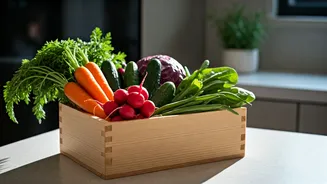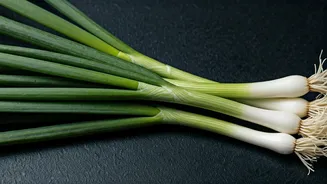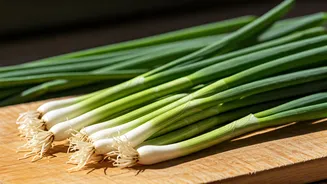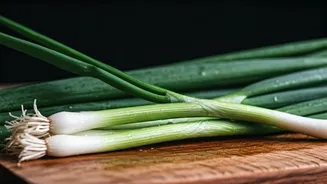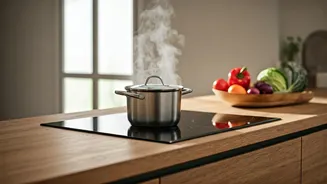Leafy Greens Love
Leafy greens like spinach, methi, and coriander are delicate and require careful handling. To store them, wash the greens thoroughly and remove any damaged
leaves. One effective method is to blanch them before freezing. Blanching involves briefly immersing the greens in boiling water, followed by an immediate plunge into ice water to stop the cooking process. After blanching, pat the greens dry and store them in airtight containers or freezer bags to prevent freezer burn. Alternatively, for short-term storage, you can wrap them loosely in paper towels and place them in the crisper drawer of your refrigerator. This helps absorb excess moisture and keeps them crisp.
Onions and Garlic
Onions and garlic, crucial flavor enhancers in Indian cuisine, require different storage approaches to maintain their quality. Store whole onions and garlic bulbs in a cool, dark, and well-ventilated area. Avoid storing them in plastic bags, as this can trap moisture and promote spoilage. A mesh bag or a basket is ideal for allowing air circulation. If you have cut onions or garlic, it’s best to store them in the refrigerator, wrapped tightly to prevent their strong odor from permeating other foods. For longer-term storage, consider freezing minced garlic or onions in ice cube trays or small portions. This preserves their flavor and makes them convenient to use.
Tomatoes' Tender Touch
Tomatoes require specific handling to prevent them from becoming mushy and losing their flavor. Unripe tomatoes should be stored at room temperature to allow them to ripen. Once ripe, store tomatoes in a cool, dry place away from direct sunlight. Storing them in the refrigerator can affect their texture and flavor, so avoid refrigeration unless they are already very ripe. To extend their shelf life, you can also consider blanching ripe tomatoes and then flash freezing them. This method works well for making sauces or adding to dishes later. Always use ripe tomatoes as soon as possible, and do not store them with other fruits, as this can hasten ripening.
Flash Freeze Tactics
Flash freezing is a simple technique that can significantly prolong the shelf life of many vegetables, retaining their flavor and texture. Start by washing and preparing your chosen vegetables. For leafy greens and tomatoes, blanching before freezing is highly recommended. Spread the prepared vegetables in a single layer on a baking sheet, ensuring they don't touch each other. Place the baking sheet in the freezer and let the vegetables freeze completely. Once frozen, transfer them to airtight containers or freezer bags. This method prevents the vegetables from clumping together and makes it easy to take out only the amount you need. Flash freezing is perfect for onions, garlic, and root vegetables as well.
Crisper Drawer Wisdom
The crisper drawer in your refrigerator is designed to maintain the ideal humidity levels for different types of vegetables. Generally, the crisper drawer has two sections: one with high humidity and another with low humidity. Use the high-humidity drawer for vegetables like spinach, methi, coriander, cucumbers, bell peppers, and zucchini, as they require more moisture to stay fresh. The low-humidity drawer is ideal for root vegetables, onions, and garlic. By understanding and utilizing the crisper drawer correctly, you can dramatically increase the lifespan of your produce. Consider regularly checking the produce stored in these drawers to remove any spoiled items.
Root Vegetable Readiness
Root vegetables, including carrots, beets, and radishes, require specific storage methods to prevent them from drying out or becoming soft. Remove the leafy tops from root vegetables as soon as you get them home, as these tops draw moisture from the roots. Store the root vegetables unwashed in a cool, dark, and humid environment, such as the crisper drawer of your refrigerator. Wrapping them loosely in a damp paper towel before placing them in a plastic bag helps maintain humidity and prevents them from drying out. For longer storage, consider freezing these vegetables after blanching them or, in the case of beets, after cooking them. This preserves their texture and flavor.
Control Moisture Levels
Controlling moisture is crucial for preserving the freshness of your vegetables. Excess moisture can lead to spoilage, while too little can cause wilting and dryness. For vegetables that release moisture, such as cucumbers, bell peppers, and zucchini, always pat them dry after washing. Store them in the crisper drawer to maintain optimal humidity levels. Using paper towels or clean cloths to absorb any excess moisture in the storage containers can also help. Similarly, for root vegetables, the use of damp paper towels helps maintain the right level of humidity. Regular monitoring of your stored vegetables and discarding any spoiled ones is the best way to control moisture-related spoilage.
Cucumbers, Bell Peppers, Zucchini
Cucumbers, bell peppers, and zucchini share similar storage needs. These vegetables are high in water content and prone to spoilage if not stored correctly. The best place to keep them is in the crisper drawer of your refrigerator, set to a high-humidity level. Before storing, wash and dry them thoroughly. Don't cut these vegetables until you're ready to use them, as cutting them accelerates spoilage. Place them in a plastic bag or container, but don't seal them tightly, allowing for some air circulation. For bell peppers, removing the stem and seeds can also help extend their shelf life. Regularly check these vegetables for signs of decay and use them promptly for the best quality and flavor.


